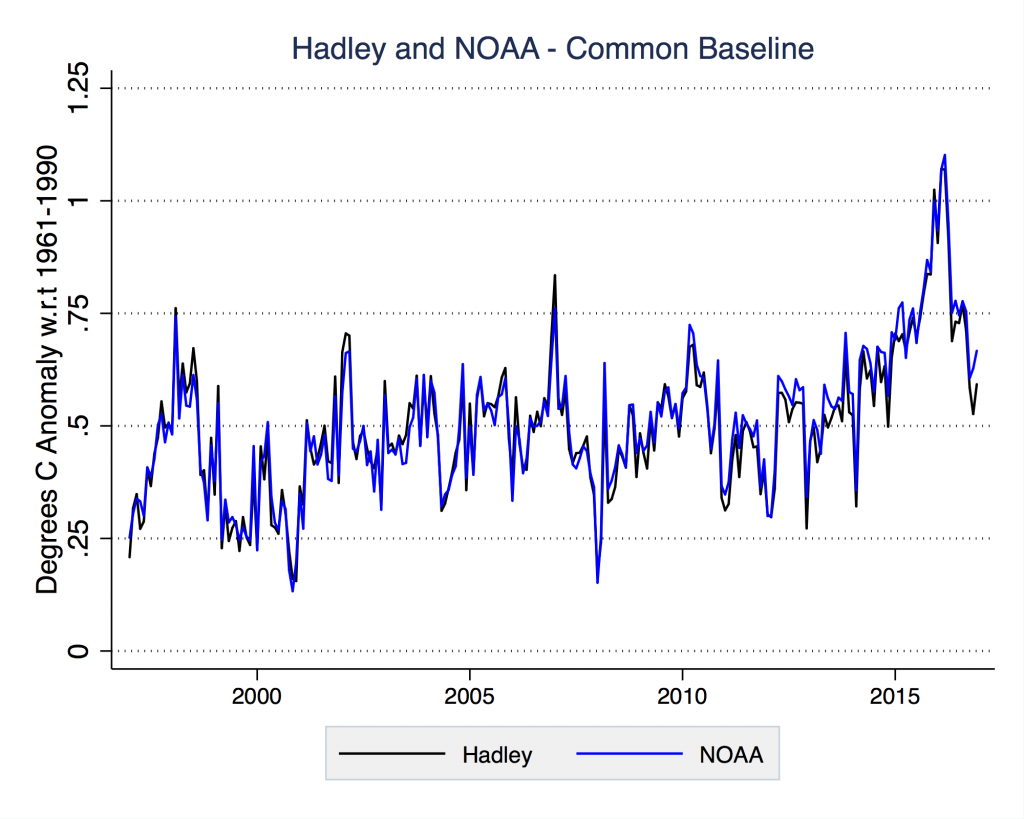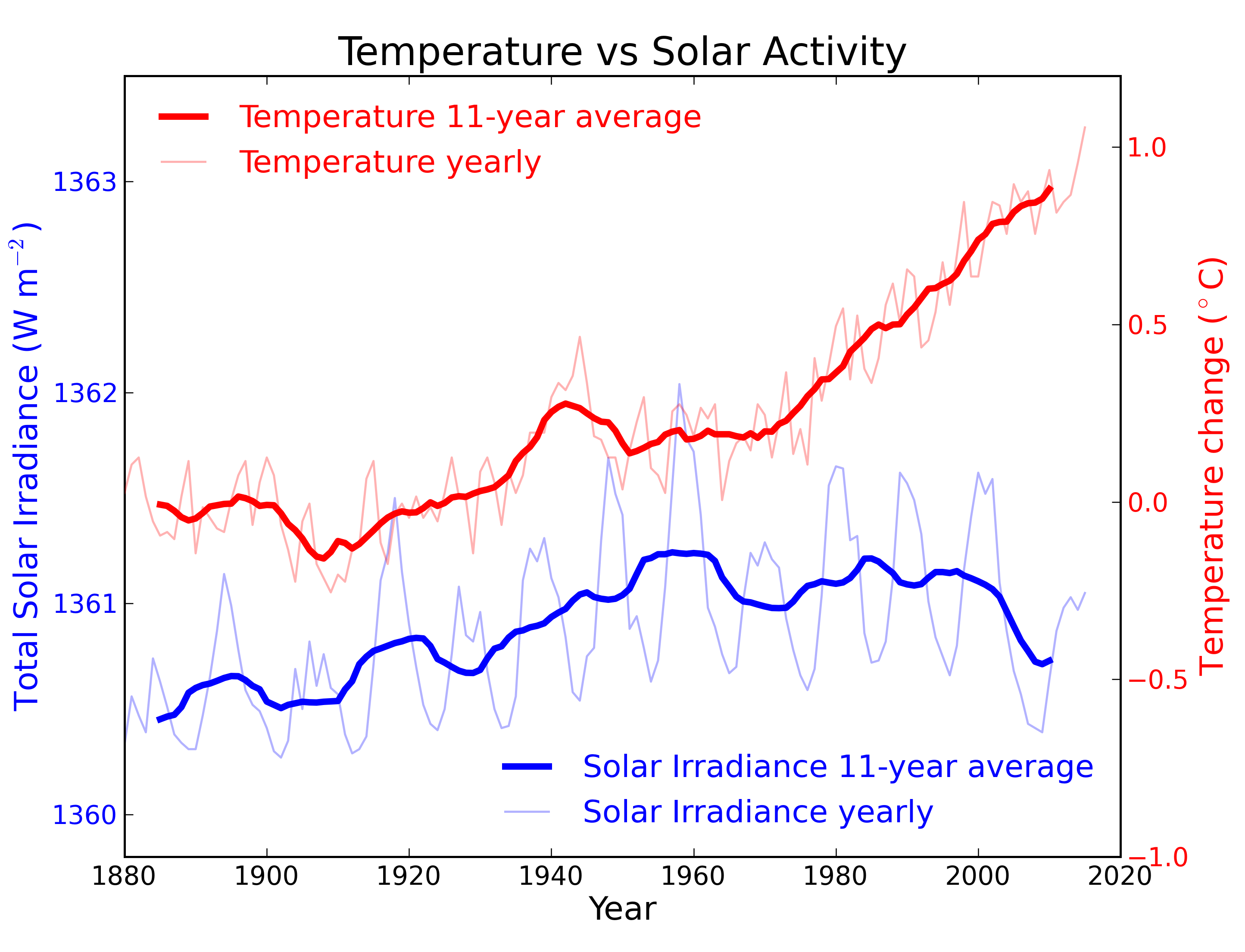Though solar activity certainly and demonstratively has effect on our planet it is not as important to our life form as atmosphere at this point. Granted climate must adjust to solar radiation and it will cause some level of disruption, but changes in atmospheric composition are relatively immediate (see Pinatubo) and ocean current changes due to warming are extreme in their climate impacts.
If our planet does indeed enter an "Ice Age" it will probably be the result of the Atlantic conveyor faltering or slowing and thus Northern latitudes losing the equatorial heating. If this happens we will slip into a new "Little Ice Age" due to climate change.
Solar activity doesn't just have an "effect"...it drives our climate, and very small changes in solar activity spell quite large changes in our climate. CO2 is a political issue, and the claims that CO2 has an effect on our climate are political claims not backed up by the first piece of observed, measured, quantified evidence that supports the AGW hypothesis over natural variability...
Research...actual science, is however beginning to wake up to the fact that it is the sun that determines the climate on planet earth and which direction it moves, and by how much.
“The main driver of the large-scale character of the warm and cold episodes may be changes in the solar activity. Four warm periods – 1626–1637, 1800–1809, 1845– 1859, and 1986–2012 – have been identified to correspond to increased solar activity” – Tejedor et al., 2017
“The activity level of the Modern Maximum (1940–2000) is a relatively rare event, with the previous similarly high levels of solar activity observed 4 and 8 millennia ago” – Yndestad and Solheim, 2017
“A large proportion of climate variations can be explained by the mechanism of action of TSI [total solar irradiance] and cosmic rays (CRs) on the state of the lower atmosphere and other meteorological parameters” – Biktash, 2017
“The solar ‘activity’ increase is the chief driver of the global temperature increase since the LIA [Little Ice Age]” – Page, 2017
“Climate … follows SA [solar activity] fluctuations on multidecadal to centennial time scales” – Moreno et al., 2017
“The emerging causal effects from SS [solar activity] to GT [global temperatures], especially for recent decades, are overwhelmingly proved” – Huang et al., 2017
Quantifying climatic variability in monsoonal northern China over the last 2200 years and its role in driving Chinese dynastic changes
It has been widely suggested from both climate modeling and observation data that solar activity plays a key role in driving late Holocene climatic fluctuations by triggering global temperature variability and atmospheric dynamical circulation … The strengthened solar activity could be significantly amplified by the variations in ultraviolet radiation as well as clouds, resulting in the marked variability in global surface temperature
Do trend extraction approaches affect causality detection in climate change studies? - ScienceDirect
Various scientific studies have investigated the causal link between solar activity (SS) and the earth’s temperature (GT). [T]he corresponding CCM [Convergent Cross Mapping] results indicate increasing significance of causal effect from SS [solar activity] to GT [global temperature] since 1880 to recent years, which provide solid evidences that may contribute on explaining the escalating global tendency of warming up recent decades. … The connection between solar activity and global warming has been well established in the scientific literature. For example, see references [1–10]. … Among which, the SSA [Singular Spectrum Analysis] trend extraction is identified as the most reliable method for data preprocessing, while CCM [Convergent Cross Mapping] shows outstanding performance among all causality tests adopted. The emerging causal effects from SS [solar activity] to GT [global temperatures], especially for recent decades, are overwhelmingly proved, which reflects the better understanding of the tendency of global warming.
SAGE Journals: Your gateway to world-class journal research
This paper demonstrates that global warming can be explained without recourse to the greenhouse theory. This explanation is based on a simple model of the Earth’s climate system consisting of three layers: the surface, a lower and an upper atmospheric layer. The distinction between the atmospheric layers rests on the assumption that the latent heat from the surface is set free in the lower atmospheric layer only. The varying solar irradiation constitutes the sole input driving the changes in the system’s energy transfers.
Mid-late Holocene climatic changes recorded by loess deposits in the eastern margin of the Tibetan Plateau: Implication for human migrations - ScienceDirect
A warmer and wetter climate prevailed since ∼4800 a BP and was interrupted by a sharp cold reversal at approximately 3300 a BP that was likely caused by solar irradiance forcing, which resulted in a global cold climatic change and glacier advance.
http://www.tandfonline.com/doi/pdf/10.1080/16742834.2017.1321951
Solar wind and electric-microphysical process is the key mechanism that affects climate …
[T]he wintertime Iceland Low in the North Atlantic was very sensitive to solar wind variations and played an important role in the process of solar wind and electric-microphysical effects on climate. Tinsley and Zhou (2015) improved the collision and parameterization scheme that varied with electric quantity in a cloud microphysics process and quantitatively evaluated the effects of high-energetic particle flux on cloud charge. This achievement not only supports the marked association of solar activity with weather and climate change on various time scales, but also but also avails the quantitative accession of solar impacts on climate.
http://orbi.ulg.ac.be/handle/2268/207496
A deeper analysis reveals several periods of significant rapid climate change during the Holocene (at 10.7-9.2 ka, 8.2-7.9 ka, 7.2-6.2 ka, 4.8-4.5 ka, and 3-2.4 ka BP),
which are similar to the cold events detected from different natural paleoclimate archivers. A comparison between the geochemical analysis of Père Noël speleothem and solar activity (sunspot number) reveals a significant correlation. Spectral analysis methods reveal common solar periodicities (Gleissberg cycle, de Vries cycle, unnamed 500 year, Eddy cycles, and Hallstatt cycle). The geochemical analyses have the potential to prove that PN speleothem is sensitive to changes in solar activity on centennial and millennial timescales during the Holocene.
https://www.irsm.cas.cz/materialy/acta_content/2017_doi/Ma_AGG_2017_0008.pdf
The modulation action from solar activity plays an important role in the temperature change, and there is a possible association existing in the global land-ocean temperature and solar activity on decade time scales. … About 11-year period, a remarkable oscillation of solar activity, continually exists in wavelet transform of solar variation. According to the cross wavelet transform, solar activity influences global land-ocean temperature change on ~11-year time scales during 1935-1995 with above the 5 % significance level.
http://www.sciencedirect.com/science/article/pii/S0031018217300044
Late Holocene climate change in coastal East Asia was likely driven by ENSO variation. Our tree pollen index of warmness (TPIW) shows important late Holocene cold events associated with low sunspot periods such as Oort, Wolf, Spörer, and Maunder Minimum. Comparisons among standard Z-scores of filtered TPIW, ΔTSI, and other paleoclimate records from central and northeastern China, off the coast of northern Japan, southern Philippines, and Peru all demonstrate significant relationships [between solar activity and climate]. This suggests that solar activity drove Holocene variations in both East Asian Monsoon (EAM) and El Niño Southern Oscillation (ENSO). In particular, the latter seems to have predominantly controlled the coastal climate of East Asia to the extent that the influence of precession was nearly muted during the late Holocene.
http://www.sciencedirect.com/science/article/pii/S0273117716306512
[/quote]
Significant correlation was found between SST [sea surface temperatures] in NA [the North Atlantic] and solar activity (both instrumental data and proxies) during AD 1716–1986. …
Thus, the connection between Northern Fennoscandian climate and solar activity, which has been previously established at century-scale (Ogurtsov et al., 2001, 2002, 2013)
and millennial-scale (Helama et al., 2010),
is confirmed for AD 1716–1986 over the entire frequency range using unfiltered records (with the exception for AMO reconstruction after Mann et al. (2009)). …
Changes in solar ultra-violet (UV) radiation might provide a solar-climatic link over Northern Europe. Actually, modeling work by (Ineson et al., 2011) showed that that
solar UV (200-320 nm) decadal variability drives appreciable temperature changes in mesosphere and upper stratosphere largely through absorption of UV by ozone. This variation results in a corresponding change in the pattern of stratospheric winds, which propagates downwards and appreciably influences atmospheric circulation over the North Atlantic basin. Studies using an atmosphere–ocean coupled climate model have shown that
solar-induced changes in atmospheric circulation also influence changes of heat storage in North Atlantic Ocean that can integrate and amplify solar effect (Ineson et al., 2011; Scaife et al., 2013). [/quote]
https://www.researchgate.net/public...ew_insights_from_W_coast_Portuguese_estuaries
[/quote]Understanding the
Sun-Earth’s climate coupling system is both an essential and an urgent issue, with great progress achieved over the last decades (e.g., Haigh, 2007; Soon et al., 2014 for a review). Recently, Brugnara et al. (2013) referred that the Euro–Atlantic sector, in which Portugal is located, seems to be a region with a
particularly strong solar influence on the troposphere, finding a significant change in the mean late winter circulation over Europe, which culminates in detectable impacts on the near-surface climate. Jiang et al. (2015) suggested that (i)
climate in the northern North Atlantic regions follows SA [solar activity]
fluctuations on multidecadal to centennial time scales, and (ii) it is more susceptible to the influence of those fluctuations throughout cool periods with, for instance, less vigorous ocean circulation. Similar results were found by Gómez-Navarro et al. (2012) in the context of climate simulations for the second millennium over the Iberian Peninsula, recognizing that
temperature and precipitation variability is significantly affected at centennial time scales by variations in the SA [solar activity]. …
Grand Minima and Dalton-type Minimum scenarios are broadly characterized by (i) lower TSI (i.e., lower available PAR) (Lean, 1991, and references therein), (ii)
development of cloudiness (e.g., Usoskin and Kovaltsov, 2008), and (iii)
decreased global/regional air surface temperatures (e.g., Neukom et al., 2014) in tandem with greater regional precipitation variability.[/quote]
These are just a few papers...most published in 2017....there are literally dozens of papers mostly published within the past couple of years showing how changes in solar activity drive not only temperature but storm activity, clouds, ozone, sea ice, crop yields, and precipitation changes. The sun is in charge and the climate follows variations in the sun's output. The greenhouse hypothesis and its bastard child the AGW hypothesis are on the way out. As I said, there isn't a single shred of observed, measured, quantified evidence that supports the AGW hypothesis over natural variability.





